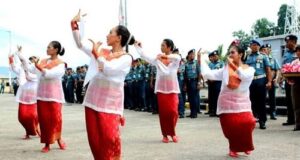Do you love traditional dances from Indonesia? The country has so many traditional dances from different tribes that live in the country, including the traditional dance from Ambon which is different from the traditional dance from Central Java. Traditional dance from Ambon has a different style from common traditional dance in Java or cultural performances in Bali.
The colonialism era that happened in Ambon inspired their traditional dance to European style. If you love to see the performance of traditional dance from Ambon, you can explore the island of Maluku. The tribes that live around the island have the richest traditional culture that is influenced by their sea living which is different from Bali tribes.
Let’s see some of the traditional dances from Ambon on the list below before you get ready to explore Ambon and the whole of Maluku Island.
1. Katreji

Katreji dance is one of the traditional dances from Ambon that is commonly performed by a couple of dancers of men and women. This kind of traditional dance brings joy to the audience which becomes the part of cultural heritage in Indonesia. Katreji dance is a traditional dance from Ambon that perform specifically for welcoming guests, Indonesian wedding traditions, and school festivals.
The joyful vibe and movement bring the most exciting moment to the audience. Katreji dance contains Portuguese and Netherland styles of dance. Every movement looks similar to their culture because of the effect of the colonialism era.
2. Cakalele

Cakalele dance is one of the traditional dances from Ambon that is well-known as the swords dance. This kind of traditional dance is performed using the traditional sword from the Maluku tribe. Cakalele dance commonly performs with 30 dancers, both men, and women.
The dance represents the patriotism and braveness of every tribe in Maluku during the colonialism era. The traditional music that followed this dance used the drum, flute, and Bia, a kind of traditional musical instrument from Maluku that comes from the shell. It brings the music to follow the Cakalele dance performance more loud and unique.
3. Tifa Lenso

Tifa Lenso dance is one of the traditional dances from Ambon that is commonly performed by youngsters. This kind of traditional dance is commonly performed by six dancers or more, but not exceeding ten dancers. Tifa Lenso represents the agreement and refusal as the answer from the girl who was proposed by their loved one.
This dance is popular among single youngsters in Maluku as a part of a sacred ceremony before they get married. Tifa Lenso’s dance performance is followed by traditional musical instruments from Ambon, such as Kolintang, Minahasa’s Tambur, Suling, and Tetengkoren.
4. Saureka Reka

Saureka Reka dance is one of the traditional dances from Ambon that looks similar to Angklek, a traditional Indonesian game. Saureka Reka is well-known as the sago tree fronds dance among Maluku’s tribes. Saureka Reka is a traditional dance from Ambon that perform by eight couple dancers both women and men.
The men will be responsible for the Gaba or the sago tree fronds, and the women would dance over those fronds. Saureke Reka commonly performs during the farming festival, and sea sailor festival, and welcomes guests as well. This dance is followed by traditional musical instruments such as Kendang and Ukulele.
5. Bambu Gila

Bambu Gila is one of the traditional dances from Ambon that becomes the most sacred dance in Maluku. The dance was played by men dancers only and using a ritual bamboo. Bambu Gila dancers should follow the instruction from the shaman before dancing.
Both the dancers and the bamboo will have a specific custom cultural ceremony led by the oldest shaman in the village. Most tribes in Maluku believe that Bambu Gila has one of their spiritual ancestors to lead the dance. Every movement is led by the spirit that infiltrates the bamboo.
6. Maku Maku

Maku Maku dance is one of the traditional dance from Ambon represent the youngster relationship among tribes in Maluku. This kind of dance is commonly performed by youngsters in Maluku. Locals believe that Maku Maku was created by their ancestors living in Nunusaku as the original tribe in Maluku before they migrate to Seram Island.
Maku Maku dance nowadays is performed by youngsters during school festivals, welcoming guests, or Independence Day celebrations.
7. Temar Rubil

Temar Rubil dance is one of the traditional dances from Ambon that is also well-known as the arrow dance. This kind of traditional dance has originally come from Kei Island. Temar Rubil dance represents the struggle of the Kei tribe to survive holding their land and women’s rights.
This dance is a symbol of patriotism against colonialism before independence was declared. Temar Rubil is commonly performed by boys or men that Kei’s tribe believes have more power to fight for women’s rights.
8. Enggo Lari

Enggo Lari is one of the traditional dances from Ambon that represent the spirit to fight. This kind of traditional dance describes of the movements hide and seek games wrapped in Maluku’s culture. Enggo Lari should be played within a unique song that specifically sings for the game.
The keeper will be called an Enggo that should fight other dancers from their touch. Once the keeper gets touched by one of them, then the dance is over. Enggo Lari is a popular traditional dance from Ambon that keeps the traditional game from Maluku existing from the extinct.
This traditional dance is commonly performed by Maluku youngsters. Now you know some of the traditional dances from Ambon by the list above. Are you ready to watch one of those dances performance? Let’s explore Maluku and the islands around it.